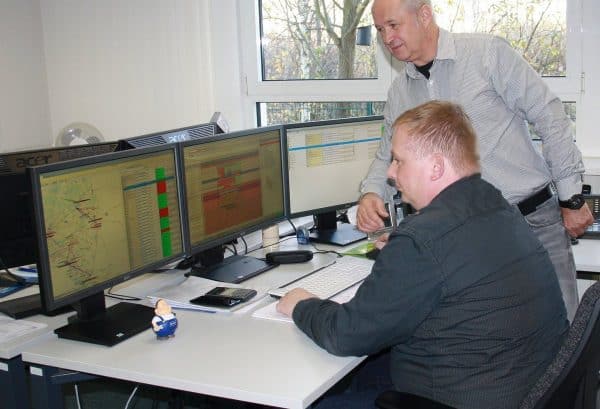
ENSO NETZ GmbH
To make the scheduling and order processing of the 150 fitters more efficient and up-to-date, the company decided to introduce a workforce management system (WFM) in 2009. To this end, the energy service provider commissioned the consulting firm Booz & Company to prepare a detailed preliminary study on WFM.
 Foremen at Enso plan network mechanics with mobileX-Dispatch
Foremen at Enso plan network mechanics with mobileX-DispatchOn the basis of the study, ENSO decided to use the mobileX-Dispatch dispatching solution from mobileX primarily because of its broad range of functions. This solution shows the dispatcher all available resources such as fitters and technical aids. Based on the order type or the technical object mobileX-Dispatch automatically determines the necessary qualifications and displays suitable resources. In the Gantt diagram or in the map display, the MRP controller assigns SAP PM orders to the available resources. The route optimization ensures that the technicians receive an optimal sequence and route for processing their orders.
The Field Service Management system was implemented in stages. In 2011, ENSO started the pilot phase with the establishment of a dispatching center in Görlitz. The other eight dispatching centres followed in 2012. In January 2013, the system was then fully productive. The training for mobileX-Dispatch took place on one day with the key users, who then trained their colleagues for the new solution. The team of dispatchers consists of one leading dispatcher per center and one or two work planners who work in a kind of rotation system. The work planner creates the operations and sub-operations in SAP PM, which the dispatcher then assigns to the technicians in mobileX-Dispatch.
All rolling resources – i.e. the mechanics’ emergency vehicles and production resources/tools – are now also stored in SAP PM and accessible for automated dispatching. The quality of the master and transaction data in the SAP systems has also improved significantly and has become more transparent. The introduction of the WFM system also has an impact on other departments. For example, the booking effort from the work reports of the fitters in the HR department has been significantly reduced. The fitters themselves can now start directly from home to their first place of work
Conclusion
In 2013, ENSO carried out an audit of the overall cost-effectiveness of the Field Service Management project based on a cost-benefit analysis. This showed that the investments had already paid for themselves within one year, partly due to the adherence to schedules of all those involved. Further gains in the form of cost savings are therefore expected for the future.
These positive results give ENSO financial scope to further develop the WFM project. At the moment, preparations are being made to introduce more powerful terminal equipment for the fitters. In the area of deployment planning, the changeover to semi-automatic scheduling should in future make it possible to control deployments up to two weeks in advance. There are also plans to extend the WFM system to include metering.

After only one year we had already achieved the objectives of the WFM system. This includes structural effects such as the introduction of centralized work preparation and scheduling in our nine dispatching centers and the reduction of distribution times. Other important gains for us are the unprecedented transparency of work tasks for the management and the automatic invoicing of all related work orders.
Dr. Jan Gerber, WFM-Projektleiter bei der ENSO NETZ GmbH

ENSO Image film

Dresden-based ENSO Energie Sachsen Ost AG is the leading utility company in Eastern Saxony. The company supplies around 500,000 customers with electricity, natural gas, water, heat, and energy-related services.
In 2012 ENSO had 679 employees and posted annual sales of €1.12 billion.
